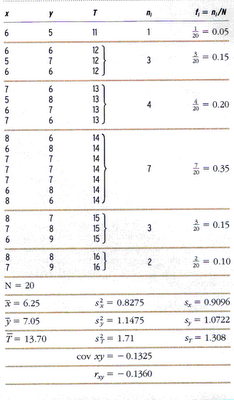My knowledge of statistics is embarrassingly poor. I've a layman's sense of what variance, covariance, and standard deviation means. The calculation part is simple. Understanding when to apply a measurement (1-tail, 2-tail, general linear model) and the significance of the result is beyond me.
I can usually skate by with just this, but I created a program which, among other things, calculates Cronbach's coefficient of alpha. From my readings, Cronbach's alpha is not a statistic, but a measure of internal consistency. As an example, does the overall exam grade reflect the overall question grades? Described as a measure of internal consistency, as I understand it alpha let's you see how the the variations on individual questions compare with the variation of the entire exam. (I've been told that the coefficient of alpha was really designed to be used on Likert scales, e.g., scales from excellent to very poor, rather than on test scores, but I'm having enough trouble wrapping my mind around the concept that I'll agree with anyone who purports to know what they're talking about.)
Onward.
I recently volunteered to analyze the stats of a recent survey figuring that I'd learned something in the process. What I learned was that the survey was not constructed well, that there was no universally accepted way of analyzing the survey, and I needed to know more about stats.
The statisticians were uniformly kind and most enjoyed themselves richly making derogatory comments about the people who constructed the survey. I could smile because I had nothing to do with creating the survey.
In the end, only one of several important questions on the survey yielded a significant result if you made certain assumptions about the responses: instructor's teaching distance learning courses seemed to think that the size of the classes they taught were appropriate. (The reason the results are questionable is that there was no indication that the instructors were answering questions about the same type of class(es).)
But that's not why I started this post. I had rewritten an Opscan/Scantron grading program and all the stats but Cronbach's Alpha worked out correctly. We know that only one instructor actually checked those statistics, so I was able to let that slide citing the press of other work. It looks as though I'll have the time now. So...
Always one to shirk duty, but having used up all my excuses, I searched the web for information about Cronbach's coefficient of alpha and was disappointed to find that the example on the NIH's web site had an error. The bleeping National Institute of Health! Sigh. Double check me: Table 18-2. Number of Teeth in the Sex Comb on the Right (x) and Left (y) Legs and the Sum of the Two (T) for 20 Drosophila Males contains an error. If you've got a moment, find the average value of column labeled x. The total of 20 numbers comes out to 133 with an average of 6.65 by my calculations. The illustration shows the average to be 6.25. The error seems to have escaped the authors and reviewers because the value of 6.65 is used about a quarter way down the page in the calculation of cov xy. The book, should you be inclided to investigage is Modern Genetic Analysis by A. J. F. Griffiths, W. M. Gelbart, J. H. Miller, R. C. Lewontin published by W. H. Freeman and Company (1999) ISBN 0-7167-3118-5.
I'm off to find another reference which will show me how to calculate Cronbach's alpha. Alternatively, maybe I can convince people that they don't need alpha calculated. Most instructors just look at the grades. Only one instructor actually looked at the kurtosis values, but then he was a Psych prof and measurements was his specialty.
A random mental walk.
Subscribe to:
Post Comments (Atom)

No comments:
Post a Comment